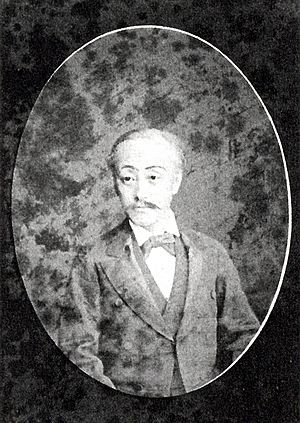Endō Taneki facts for kids
Quick facts for kids
Endō Taneki
|
|
|---|---|
| 遠藤胤城 | |

Endō Taneki, post-Meiji restoration
|
|
| In office 1863–1868 |
|
| Monarch | Shōgun |
| Preceded by | Endō Tsunenori |
| Succeeded by | < position abolished > |
| Imperial Governor of Mikami / Yoshimi | |
| In office 1869–1871 |
|
| Monarch | Emperor Meiji |
| Personal details | |
| Born | July 25, 1838 Chūō-ku, Osaka |
| Died | November 9, 1909 (aged 71) |
| Parent |
|
Endō Taneki (遠藤胤城, July 25, 1838 – November 9, 1909) was an important Japanese leader. He was the sixth and last daimyō (a powerful feudal lord) of the Mikami Domain. This was during the Bakumatsu period, a time when Japan was changing a lot. Before the Meiji Restoration (a big political shift), he held special titles. After this change, he even changed his family name to Tō.
Contents
Early Life and Becoming a Leader
Endō Taneki was born in Chūō-ku, Osaka, on July 25, 1838. He was the third son of Endō Tsunenori, who was also a daimyō. His father already had an adopted heir, Endō Tanemasa. So, young Endō Taneki was adopted by Tanemasa in 1845.
However, Endō Tanemasa passed away in 1856 before he could become daimyō. This meant that Endō Taneki was able to take over from his birth father in 1863. He became the leader of the Mikami Domain during a very busy time in Japan.
Role During a Changing Japan
As a daimyō, Endō Taneki had important jobs. He served at Osaka Castle and was a bugyō (an official) at the Kōbusho. The Kōbusho was a special school for military training run by the shogunate (Japan's military government).
In 1866, during a conflict known as the Second Chōshū expedition, he was asked to lead the Kōbusho forces into battle. The next year, in 1867, he became a sōshaban, another important role in the shogunal government.
The Meiji Restoration and New Beginnings
Japan soon entered the Boshin War, a civil war that led to the end of the shogunate. At first, Endō Taneki didn't clearly pick a side. Because of this, the new Meiji government took control of his lands.
However, just four months later, he promised to support the new government. He was then allowed to return to his lands as an imperial governor. In 1870, he moved his main base from Mikami to Yoshimi. He stayed there until 1871, when the old han system (the system of feudal domains) was ended.
Life After Public Service
After the old system ended, Endō Taneki moved to Tokyo. In 1878, he changed his family name from Endō to "Tō".
In 1884, he was given the title of viscount (shishaku). This was part of a new system called kazoku, which created a new class of nobles. In Tokyo, he became well-known for his skill in the Japanese tea ceremony. People even called him "Sōun".
He joined a special tea ceremony group called "Wakeikai" in 1898. This group included many former daimyō and military leaders. Endō Taneki passed away in 1909. His grave is at Chōkyō-ji in Taitō, Tokyo, which was his family's temple.

